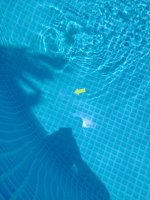Well, take that article with caution, there are many of the "classical" mistakes in it.
To start with, they don't acknowledge the the FC/CYA relationship and treat FC as an independent parameter.
A few numbers to understand what this means:
Our SLAM level (FC = 40% of CYA) is equivalent to a HOCl-concentration ("active chlorine") of about 0.3-0.31 ppm. Without CYA, this is equivalent to FC of about 0.65ppm (at pH 7.5).
Our SWG-Target level (FC = 7.5% of CYA) is equivalent to a HOCl-concentration ("active chlorine") of about 0.03 ppm. Without CYA, this is equivalent to FC of about 0.07ppm (at pH 7.5).
10 ppm FC without CYA is equivalent to a HOCl-concentration of about 4.6ppm (at pH 7.5). This is equivalent to FC=55ppm at CYA=50ppm, or FC=83ppm at CYA=80ppm or roughly FC = 100-110% of CYA.
The point is, 10ppm FC without CYA is a lot. Equivalent to about 2.5 times more than TFP's SLAM-level. On he other hand, 10ppm FC at CYA=80ppm is equivalent to about FC=0.12ppm with no CYA.
Defining an FC-limit without a correlation to CYA is absolutely meaningless. It's like saying water boils at 100°C (212°F). This number is meaningless without referring to the air pressure. On Mt Everest, where air pressure is much lower, water boils at about 68°C (154°F) - you better consider that in your cooking time for pasta.
The other major mistake they are repeating in this article, is the wrong application of the "10 times" rule for breakpoint chlorination. The correct rule is that you need about 10ppm FC (measured in units of ppm Cl
2 to get rid of 1ppm ammonia (measured in ppm N). It is wrong to state that you need 10ppm FC for each 1ppm of CC. More about that for example here:
Is anyone trying the new formula for shocking (breakpoint chlorination) that Taylor and DuPont are suggesting in this article? Seems that the latest (2009) research suggests that the formula we've been using to determine the shock level of FC is really too high and itself contributes to the...

www.troublefreepool.com


